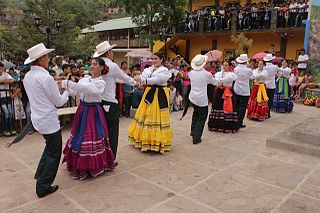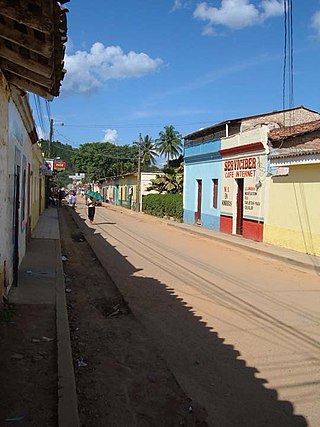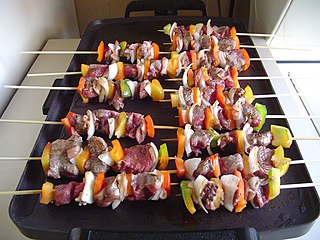
Central America is a subregion of North America. Its political boundaries are defined as bordering Mexico to the north, Colombia to the south, the Caribbean Sea to the east, and the Pacific Ocean to the west. Central America is usually defined as consisting of seven countries: Belize, Costa Rica, El Salvador, Guatemala, Honduras, Nicaragua, and Panama. Within Central America is the Mesoamerican biodiversity hotspot, which extends from northern Guatemala to central Panama. Due to the presence of several active geologic faults and the Central America Volcanic Arc, there is a high amount of seismic activity in the region, such as volcanic eruptions and earthquakes, which has resulted in death, injury, and property damage.

Honduras, officially the Republic of Honduras, is a country in Central America. Honduras is bordered to the west by Guatemala, to the southwest by El Salvador, to the southeast by Nicaragua, to the south by the Pacific Ocean at the Gulf of Fonseca, and to the north by the Gulf of Honduras, a large inlet of the Caribbean Sea. Its capital and largest city is Tegucigalpa.

Hurricane Mitch was the second-deadliest Atlantic hurricane on record. Mitch caused 11,374 fatalities in Central America in 1998, including approximately 7,000 in Honduras and 3,800 in Nicaragua due to cataclysmic flooding from the slow motion of the storm. It was the deadliest hurricane in Central American history, surpassing Hurricane Fifi–Orlene, which killed slightly fewer people in that area in 1974. Mitch was the deadliest Atlantic hurricane in the satellite era, and the second-deadliest on record in the Atlantic, only behind the Great Hurricane of 1780 which killed at least 22,000 people.

Latin American cuisine is the typical foods, beverages, and cooking styles common to many of the countries and cultures in Latin America. Latin America is a highly racially, ethnically, and geographically diverse with varying cuisines. Some items typical of Latin American cuisine include maize-based dishes arepas, empanadas, pupusas, tacos, tamales, tortillas and various salsas and other condiments. Sofrito, a culinary term that originally referred to a specific combination of sautéed or braised aromatics, exists in Latin American cuisine. It refers to a sauce of tomatoes, roasted bell peppers, garlic, onions and herbs. Rice, corn, pasta, bread, plantain, potato, yucca, and beans are also staples in Latin American cuisine.

The wealth of cultural expression in Honduras owes its origins primarily to being a part of Latin America but also to the multi-ethnic nature of the country. The population comprises 90% Mestizo, 7% Amerindian, 2% Black, and 1% Caucasian. This influences all facets of the culture: customs, practices, ways of dressing, religion, rituals, codes of behavior and belief systems.

Tela is a town, with a population of 39,920, and a municipality in Honduras on the northern Caribbean coast. It is located in the department of Atlantida.

A pupusa is a thick griddle cake or flatbread from El Salvador, Honduras, Nicaragua, and Guatemala made with cornmeal or rice flour, similar to the Colombian and Venezuelan arepa. In El Salvador, it has been declared the national dish and has a specific day to celebrate it. It is usually stuffed with one or more ingredients, which may include cheese, chicharrón, squash, or refried beans. It is typically accompanied by curtido and tomato salsa, and is traditionally eaten by hand.

The National Autonomous Federation of Football of Honduras, known as FENAFUTH, is the official football governing body in Honduras and is in charge of the Honduras national team. FENAFUTH was founded in 1951 and joined FIFA the same year. It joined CONCACAF in 1961.

Campamento is a municipality in the south west of the Honduran department of Olancho, south of Concordia and west of Juticalpa. The municipality of Campamento is located at the entrance to Olancho, along the main highway from Tegucigalpa. The town of Campamento is located near the center of the municipality, just north of the main highway.
El Rosario is a town and a municipality in the west of the Honduran department of Olancho.

Protección is a municipality in the Honduran department of Santa Bárbara.

Honduran cuisine is a fusion of Mesoamerican, Spanish, Caribbean and African cuisines. There are also dishes from the Garifuna people. Coconut and coconut milk are featured in both sweet and savory dishes. Regional specialties include sopa de caracol, fried fish, tamales, carne asada and baleadas. Other popular dishes include meat roasted with chismol and carne asada, chicken with rice and corn, and fried fish with pickled onions and jalapeños. In the coastal areas and the Bay Islands, seafood and some meats are prepared in many ways, including with coconut milk. Among the soups the Hondurans enjoy are bean soup, mondongo soup, seafood soups and beef soups. Generally all of these soups are mixed with plantains, yuca, and cabbage, and served with corn tortillas.
The Central American crisis began in the late 1970s, when major civil wars and communist revolutions erupted in various countries in Central America, causing it to become the world's most volatile region in terms of socioeconomic change. In particular, the United States feared that victories by communist forces would cause South America to become isolated from the United States if the governments of the Central American countries were overthrown and pro-Soviet communist governments were installed in their place. During these civil wars, the United States pursued its interests by supporting right-wing governments against left-wing guerrillas.

The October 2008 Central America floods were caused by a series of low-pressure areas including Tropical Depression Sixteen, a short-lived tropical cyclone in the 2008 Atlantic hurricane season that made landfall in Honduras. Heavy rainfall began in early October 2008 while a tropical wave passed through the region. On October 14, Tropical Depression Sixteen formed just off the northeast coast of Honduras, and at the same time a low-pressure system was on the Pacific coast. Both systems increased rainfall across the region, although the depression dropped heavy rainfall close to its center when it moved ashore on October 15. Although Tropical Depression Sixteen quickly dissipated over land, its remnants persisted for several days. Another low-pressure area interacted with a cold front on October 21, adding to the rainfall in the region.

A flour tortilla or wheat tortilla is a type of soft, thin flatbread made from finely ground wheat flour. Made with flour- and water-based dough, it is pressed and cooked, similar to corn tortillas. The simplest recipes use only flour, water, fat, and salt, but commercially-made flour tortillas generally contain chemical leavening agents such as baking powder, and other ingredients.

Tostones are twice-fried plantain slices commonly found in Latin American cuisine and Caribbean cuisine. Most commonly known as tostones in Jamaica, Puerto Rico, Mexico, Nicaragua, Cuba, Dominican Republic, Honduras and Venezuela, they are also known as tachinos or chatinos (Cuba), bannann peze (Haiti), patacones and, sometimes, patacón pisao in Colombia.

The coffee production in Honduras played a role in the country's history and is important for the Honduran economy. In 2011, the country became Central America's top producer of coffee.

Coffee production in Guatemala began to develop in the 1850s. Coffee is an important element of Guatemala's economy.

The Central American dry forests ecoregion, of the tropical and subtropical dry broadleaf forests biome, is located in Central America.
Climate change in Honduras is a major challenge for Honduras as it is one of the countries which is most at risk from climate change. The frequency of natural disasters in Honduras, such as floods, mudslides, tropical storms and hurricanes, is expected to increase as climate change intensifies. Over 40 percent of Hondurans work in the agricultural sector, which is impacted by increasing temperatures and reduced rainfall. However, agriculture could be dramatically impacted, which can hurt certain households in Honduras. Sanitation and food access is a major issue that is increasing due to climate change, as well as the loss of habitats for several endangered organisms.


















